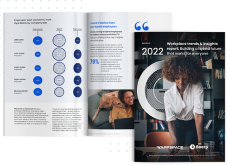
While organizations used to simply pay lip service to diversity and inclusion, in recent years, it has become a significant source of competitive advantage and a key enabler of growth. In fact, numerous studies have shown that greater diversity in the workforce results in improved profitability and value creation.
For example, research by McKinsey shows that companies in the top quartile for gender diversity experience outperform others by 21%. For ethnic and cultural diversity, there is a 33% likelihood of outperformance.
From a brand perspective, consumers are increasingly aware of the relationship between what’s happening inside and outside of a company. Many people want to do business with organizations that reflect their own values. Companies want to be on the ‘right side’ of social issues.
From an internal perspective, not only does an inclusive environment help companies attract and retain the best talent globally, but it also helps employees achieve their full potential.
Investing in communication and collaboration tools such as a digital workplace can go a long way when creating a diverse and inclusive environment where all employees’ voices and ideas can be ‘heard’.
5 reasons why diversity and inclusion matters
The current economic environment presents unique challenges as well as new possibilities for many businesses as they re-examine their operating models and navigate an uncertain future. To succeed, leaders and employees need a vision, enhanced problem-solving skills and the strategic agility to capitalize on emerging opportunities. These are likely to be stronger in organizations that can draw on the full spectrum of diverse talent available to them.
Here are our top 5 reasons why employee diversity matters to organizations in 2020 and beyond:
- Improved ability to recruit and retain the most talented employees. People want to work for organizations where they can bring their ‘whole selves’ to work. By creating an environment where everyone feels valued and respected, workers are more likely to perform at their best and go the extra mile for customers and colleagues. When individuals feel a sense of belonging, their performance improves.
- Increased customer insight and innovation. Research suggests that diverse teams are more innovative and better at anticipating shifts in customer needs that make new products and services possible, potentially generating a competitive edge.
- An inclusive culture can be a powerful driver of resilience. Organizations and employees are increasingly drawing on resilience to manage the effects of the pandemic, and companies with inclusive cultures tend to be most resilient. Visible, trusted and authentic leadership is an essential element. The ability for organizations to have an ongoing two-way dialogue with employees fuels this.
- Improved teamwork and engagement. With remote working set to stay, organizations need to ensure that people continue to feel highly connected with their goals and priorities. Diverse teams bring a wider spectrum of ideas and ways of thinking, focusing on what is most important to the organization. Engagement is driven by shared successes and trusted relationships between team members with different points of view.
- Enhanced decision making. As organizations capitalize on new ways of doing business, creating a diverse environment encourages multiple perspectives to bear on complex problems, boosting the odds of more creative solutions. Employees who feel empowered to participate and contribute are more likely to deliver a better outcome for the business and their customers.
Encouraging diversity and inclusion using a digital workplace – the 6 ‘C’s of success
A digital workplace can be an essential tool to encourage a thriving, highly productive diverse workforce within organizations. The ability to foster an inclusive global environment fuels an engaging employee experience.
The digital diversity and inclusion agenda can be facilitated through our 6 ‘Cs’:
1. Communicate
Sharing ongoing commitments for diversity and inclusion helps provide a narrative about the importance of the issue. A digital workplace is a great tool to share stories about corporate diversity programs, events and opportunities for ‘unconscious bias’ training.
An important element of successful communication is to ensure that messages are included in organization-wide communications, such as messages from the CEO and other leaders. Embedding diversity into regular communications will increase the feeling that this is part of ‘how we do things here’ rather than seeing it as a separate initiative.
2. Create
Creating Employee Resource Groups continues to be top of the agenda for many organizations. From Women’s Networks to LGBTQ+ groups, to BAME communities, disability groups, religious networks and more, the ability for people to belong, contribute and support a cause that is meaningful to them helps to create a feeling of connection and empowerment.
Encouraging and supporting online communities is a great way for organizations to foster understanding, involvement and excitement around the key activities that are important to diverse communities of employees.
3. Connect
Connecting groups of people across locations, functions and time-zones is essential to creating inclusive workplaces. As organizations are transforming, it is especially important for all employees to feel connected with senior leaders. This can be easily facilitated through online live Q&As, blogs and video messages.
4. Collaborate
While the traditional functions of a business such as marketing, sales, operations and product development haven’t changed that much over the past few years, the diverse pool of talented employees that fill those roles continues to transform. Remote working has allowed organizations to select new employees from a much more diverse global pool.
Technology such as a digital workplace has enabled integrated “on-demand” agile teams, offering the ability to tap into extensive networks of innovators, technical experts, and sales professionals who can collaborate together. It also enables employees to be able to work at a time and place that suits them, attracting new types of workers who may not be able to work traditional 9 – 5 hours.
5. Crowdsource
Aristotle first mentioned the phrase the “wisdom of the crowds” – an idea that large, diverse groups of people are collectively smarter than individual experts when it comes to problem-solving, decision making, innovating and predicting. The quickest and most cost-effective method of finding innovative solutions to business problems is to tap into diverse and varied ideas from employees.
A digital workplace is a perfect tool to foster an ongoing dialogue with employees, encouraging their opinions, voices and suggestions. Employees increasingly want to be able to contribute their feedback and ideas as businesses face unprecedented customer opportunities and challenges.
6. Culture
Creating a culture where diverse thoughts, ideas and experiences are encouraged and valued is perhaps the most important of all. Creating a culture where every individual can contribute their full potential requires buy-in and commitment from the entire organization.
Leaders need to lead by example, recruiting and promoting individuals that may have very different backgrounds and skills to themselves. Providing the tools to communicate, collaborate, feel involved in corporate decisions, listen to others and feel heard themselves drives change and success.
Digital workplaces are key for enabling diversity and inclusion
With a diverse employee base increasingly recognized as a competitive advantage, 2020 has fast-tracked the need for organizations to do more to create a more inclusive employee experience for all employees. Companies need to attract new employees with the skills and experiences to deliver different products and services.
Creating an employee experience that values different ideas and perspectives is essential for organizations to thrive and survive. Enabling people through consumer-grade enterprise software such as a digital workplace or a social intranet will foster empowerment, drive productivity and help businesses to serve customers more effectively.
.jpg?width=720&name=Beezy_eBook_CTA%20banner-01-01%20(1).jpg)


